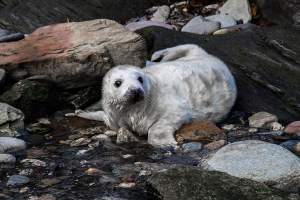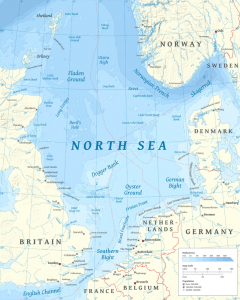Advances in Understanding Grey Seal Pup Behavior
By Emma Schillerstrom, SRC Intern
Grey seals are pinnipeds which inhabit the North Atlantic Ocean. They were once popularly hunted, and until 1967, grey seal numbers in the North Sea had dwindled to near absence for centuries (Peschko, et al., 2020). Today, the population counts are steadily rising, and they are protected under the Marine Mammal Protection Act (Magera, Flemming, Kaschner, Christensen, & Lotze, 2013).

Image of a grey seal pup (Jaan Minakov, CC BY 4.0 https://creativecommons.org/licenses/by/4.0>, via Wikimedia Commons).

A map of the North Sea (Halava, CC BY-SA 3.0 https://creativecommons.org/licenses/by-sa/3.0>, via Wikimedia Commons).
After birth, grey seals wean for 15 to 18 days before their mother leaves. After, they are left on their own to undergo a fasting period followed by around 36 days of learning to forage (Peschko, et al., 2020). Researchers in Germany teamed up to investigate how grey seal pups in the southern North Sea disperse during their early stages of life (Peschko, et al., 2020). How they fare during early development determines whether they will survive past their first year of life, join the adult population, and reproduce successfully (Peschko, et al., 2020).
From 2015 to 2017, the scientists glued satellite tags to the backs of 11 grey seals found on Helgoland, a small German island in the North Sea. Each seal was a pup aged around 6 to 8 weeks. These tags provided the position of the seal each time it surfaced and paused data collection when it returned to land. The tags collected environmental data, including the water depth and distance from land, while also keeping track of temporal data, such as the number of weeks passed since the animal was originally tagged.

An aerial view of Helgoland where the seal pups were tagged (Pegasus2, CC BY-SA 3.0 <http://creativecommons.org/licenses/by-sa/3.0/>, via Wikimedia Commons).
The researchers were able to innovatively use tag data to understand the seals’ specific behavior patterns. Behavior was assessed using a three-part classification system based on the seal’s velocity and turning angle. High velocity with a low turn angle was classified as “fast travelling”, low velocity travel with a low turn angle was considered to be “slow travelling or resting”, and high turn angle, regardless of velocity, was identified as “foraging”. The tags were removed naturally by the seals’ annual molting (Peschko, et al., 2020).
They discovered that the pups stayed close to the island for the first week before beginning to disperse along coasts. The seals remained in waters shallower than 40 meters until at least four weeks old. The frequency of foraging increased over time until week seven then decreased thereafter. This suggests that the pups hunt more frequently as they develop their skills and less frequently once they have refined their abilities and their efforts become more efficient (Peschko, et al., 2020). Additionally, the distance travelled from the island and the frequency of fast travel increased with age, likely correlated with improved swimming ability (Peschko, et al., 2020).
Characterizing their behavior and habitat use early on is crucial for assessing the population’s adaptability as well as determining what may impact its survival. Pollution, bycatch, oil spills, and heavy boat traffic pose threats to grey seals (Gray Seal Conservation and Management, n.d.). If these anthropogenic hazards occur in an area where young tend to disperse, this could prevent the seals from maturing and reproducing, rapidly sending the population toward extinction. Therefore, knowing how the young disperse allows for more-informed conservation efforts to be established.
Works Cited
Gray Seal Conservation and Management. (n.d.). Retrieved from National Oceanic and Atmospheric Administration: https://www.fisheries.noaa.gov/species/gray-seal#conservation-management
Magera, A., Flemming, J., Kaschner, K., Christensen, L., & Lotze, H. (2013). Recovery Trends in Marine Mammal Populations. PLOS One.
Peschko, V., Muller, S., Schwemmer, P., Merker, M., Lienau, P., Rosenberger, T., . . . Garthe, S. (2020). Wide dispersal of recently weaned grey seal pups in the Southern North Sea. ICES Journal of Marine Science, 1762–1771.

![Study area for the case study which shows the Bonneville Dam and the East Mooring Basin where the males aggregate [Schakner et al., 2016]](https://sharkresearch.rsmas.miami.edu/wp-content/uploads/2017/04/Figure-1-SRC-300x112.png)
![A California sea lion (Zalophus californianus) goes for a swim [Wikipedia Commons]](https://sharkresearch.rsmas.miami.edu/wp-content/uploads/2017/04/Figure-2-SRC-300x225.jpg)